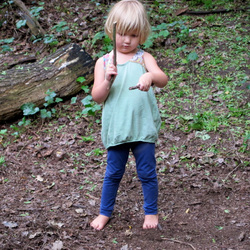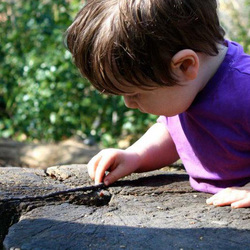 Written by Clare Caro How do we foster a love of nature and evolve imaginations and creativity in our young children? The answer is simple; take your children out into nature and leave the toys behind. At Nature Play we do not bring toys, we are there to bond with nature, not with toys. Without toys your child shifts her attention, exploring and sourcing objects of interest from the natural environment. It is this shift that opens up the world to your child; a world full of wonder, rich information, imagination and creativity, a world where play offers a two-way dialogue between your child and the natural living world she is a part of. Children learn and bond with the earth, and in turn, the earth provides the perfect place for their play to take place. The biology to learn When children are left to their own devices in a natural environment they play out the genetically encoded mammalian-human play urges inherent in every child. Every child is born to move, grow, explore… and it is these processes that develop their minds and bodies. When children are free to follow this ‘biological design’, nature takes its course. All the child needs is freedom of movement, a safe environment, opportunity for uninterrupted play, and access to the sensory-rich natural environment. Open world The possibilities are endless when you enter a natural environment. Every garden, beach, stream and glade offers many multi-sensory learning opportunities for every age and stage of development. Touching, listening, collecting stones, throwing sticks, crawling up and sliding down slopes, and building structures that are furnished by the imagination - all play in a natural environment ensures a master-class with the natural materials. While there are no risk-assessed safety-regulated slides, climbing frames or ladders in sight, the natural environment offers a wider range of resources. Gentle slopes or fallen logs can be just the right challenge for the young crawler as well as for the more mobile children who need to race, roll and jump. Renowned playground designer Günter Beltzig explains that far from being dangerous, the ideal playground "offers visible, manageable risks, as playing is all about testing and transcending one's limits." Something that is readily available in nature’s ‘play grounds’. Explore and gather information In their exploratory play, children gather information and make their own knowledge of their world. The young baby gathers information about the environment and their world as fast as 40 million bits per second, without filtering any of it out. Their senses gather information, creating a super-highway of multi-sensory information that feeds into a growing brain. In turn, it is this multi-sensory stimulation that causes the brain to grow. When things are new, never seen or experienced before, a child needs to feel it, taste it, smell it, weigh it, balance it, step inside it... and the longer children play with the new treasure, the more information they gather. This information, gathered in the top-speed-download mode, ensures that the child grows a rich and full ‘vocabulary-treasury’ of their world. "The most influential perceptual programming of the subconscious mind occurs in the time period spanning from the birth process through the first six years of life. During this time the child’s brain is recording all sensory experiences as well as learning complex motor programs for speech, and for learning first how to crawl and then how to stand and ultimately run and jump." - Dr Bruce Lipton  Three-dimensional imaging Imaginative play is the highest form of play, it is play where anything and everything is possible. The stepping-stone into imaginary play is exploratory play because in order to call up images and play with them, you first have to have a file of information-images to call upon. You cannot imagine a pineapple if you have never seen, touched, smelt or held one before. In imaginary play, the child calls up mental images from her memory files and 'alters her world': the pinecone becomes the pineapple, the tree becomes a horse, or boat, or a den. She lives and plays, not in a two-dimensional virtual world, but in a three-dimensional world of her own making. “The inner image in the absence of the exterior image. This is where words can stimulate the highest cortical systems of the brain—not the sensory motor system, not the emotional cognitive system—in coordination with the other two brains to create, out of its own processes, an image.” - Joseph Chilton Pearce Natural objects inside At a very deep and subconscious level, many of us recognise our children need a connection with the natural world. If we are not careful, we can find ourselves surrounding our babies with fake representations of nature, everything from furry rabbits to winged insects made from brightly coloured, textured fabrics to 'tickle the baby's senses'. But what do children learn with these unnatural objects? How can they learn vocabulary that will serve them in nature? Their biological drive to gather information about the world is, - for many in our culture - met with ‘useless information’ about an object that holds no relevance in the real, natural, living world. While it is not always convenient to take our children outdoors into nature, there is plenty of quality exploration and information-gathering time to be had indoors too. This is good news for young babies in wintertime when it is too cold to lay or crawl on the ground. Inside we are able to make treasures from the natural environment available - a cluster of scallop shells, a basket of horse-chestnut conkers, a tray of beach mast, for smaller babies wooden bowls and rings, cloths from hemp, cotton or wool - these are known as ‘open-ended’ objects, meaning the possibilities they present are endless. They can facilitate indoor exploration and play for all stages and ages when getting out on the earth is not feasible. By exchanging a world of plastic toys and synthetic furry or 'sensory' animals for the smörgåsbord of flowers, shells, stones, pinecones, silver birch seeds we can bring inside, we move away from an attachment to the artificial world. Synthetic materials hold no information about how the earth turns through the seasons of our lives, nor do they hold any magic compared to a bird’s nest, the patterns of a pinecone, or the miracle of a birch seed. By removing the synthetic toys and stage-dependent playground equipment from the environment, and by taking our children outside into the nature places where they have regular contact with the natural treasures of this planet, we set up the perfect conditions for imaginative play. We will be privileged to see imagination unfold, as a deep connection with the earth forms in each child. What the child needs to unfold is met with what the earth has to offer. By supporting this first relationship both the Earth and the Earthling benefit and thrive. Article originally published in The Space magazine. Subscription available at www.childspace.co.nz, free post to overseas subscribers. ...take me back to the A R T I C L E S menu. Comments are closed.
|
|
Copyright © 2024 Nature Play
|

 RSS Feed
RSS Feed